MAPS, a stylish activity format to enhance Thai language learning skills Grade 4
Keywords:
framework, MAPS, linguistic skillsAbstract
The objectives of this research were to 1) design an activity with MAPS empowerment activity framework 2) study the learners' five aspects of learning Thai linguistic skills after participating in activities aligning to the MAPS empowerment activity framework and 3) study the satisfaction of parents towards MAPS empowerment activity framework. The sample group used in this research was 20 primary 4 students. The research instruments were 1) lesson plans for activities aligning to MAPS empowerment activity framework 2) assessment form for five aspects of Thai linguistic skills of learners after studied and 3) a questionnaire on the satisfaction of parents towards the MAPS empowerment activity framework. The statistics used in this research were an average, a standard deviation. The findings were found MAPS consist of ‘M’ motivation, motivate student to attend in activity. ‘A’ Acquire, cognitive with experience through one’s own work. ‘P’playfulness, create a learning experience that consists of a commitment to learn happily. ‘S’ stage, student get a stage to introduce things their work that quality the MAPS empowerment activity framework was overall at a high level (with an average = 4.48, a standard deviation = 0.45). Parents' satisfaction toward the MAPS empowerment activity framework was at a high level. (with an average =3.69, a standard deviation = 0.52)
References
กาญจนา นาคสกุล. (2551). การใช้ภาษา. เคล็ดไทย.
คณะกรรมการวิชาภาษาไทยเพื่อการสื่อสาร. (2554). ภาษาไทยเพื่อการสื่อสาร. ศูนย์วิชาการบูรณาการหมวดวิชาศึกษาทั่วไป มหาวิทยาลัยเกษตรศาสตร์. สำนักพิมพ์มหาวิทยาลัยเกษตรศาสตร์.
ดวงกมล พลคร. (2553). การพัฒนาแบบประเมินทักษะทางภาษาสำหรับเด็กปฐมวัย. วิทยานิพนธ์ครุศาสตร
มหาบัณฑิต มหาวิทยาลัยราชภัฏเพชรบูรณ์.
บุญชม ศรีสะอาด. (2545). การวิจัยเบื้องต้น (พิมพ์ครั้งที่7). สุวีริยาสาส์น.
บุหลง ศุภศิลป์. (2554). รูปแบบการจัดประสบการณ์แบบบูรณาการเพื่อเสริมสร้างความสามารถทางการฟัง– พูดภาษาอังกฤษสำหรับเด็กปฐมวัย. Research and Development Journal Suan Sunandha Rajabhat University, 9(2).
ปทิตตา ปิยสกุลเสวี. (2558). การประเมินหลักสูตร Young Professional ท้าทายผัน วิชาชุมนุมเมล็ดพันธ์แห่งปรีชาญาณ. วิทยานิพนธ์ปริญญาศึกษาศาสตร์มหาบัณฑิต. มหาวิทยาลัยเทคโนโลยีราชมงคลธัญบุรี.
พิชิต ฤทธิ์จรูญ. (2548). หลักการวัดและประเมินผลการศึกษา. (พิมพ์ครั้งที่ 3). เฮาส์ ออฟ เคอร์มิสท์.
ภูมิศรัณย์ ทองเลี่ยมนาค. (2563, 16 มิถุนายน). สำรวจผลกระกระทบหลัง COVID-19 จุดเปลี่ยนครั้งสำคัญของการศึกษาโลก. https://workpointtoday.com/education-covid 19.
เยาวลักษณ์ อินสุวรรณ์. (2541). การสร้างแบบฝึกการฟังภาษาไทยสำหรับเด็กปฐมวัย. เคล็ดไทย.
สำนักงานคณะกรรมการการศึกษาขั้นพื้นฐาน. (2564). แนวทางการจัดการเรียนการสอนใน สถานการณ์การแพร่ระบาดของโรคติดเชื้อไวรัสโคโรนา 2019 ( COVID -19 ) https://www.vec.go.th
Ann Miles Gordon and Kathryn Williams Browne. (1985). Beginnings and Beyond: Foundations in Early Childhood Education. Delmar Publishers.




